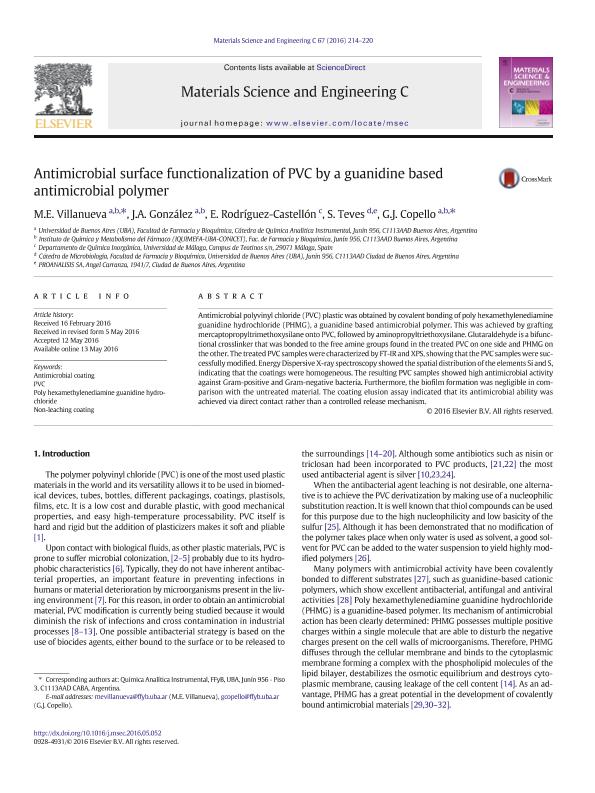Artículo
Antimicrobial surface functionalization of PVC by a guanidine based antimicrobial polymer
Villanueva, María Emilia ; González, Joaquín Antonio
; González, Joaquín Antonio ; Rodríguez Castellón, E.; Teves, S.; Copello, Guillermo Javier
; Rodríguez Castellón, E.; Teves, S.; Copello, Guillermo Javier
 ; González, Joaquín Antonio
; González, Joaquín Antonio ; Rodríguez Castellón, E.; Teves, S.; Copello, Guillermo Javier
; Rodríguez Castellón, E.; Teves, S.; Copello, Guillermo Javier
Fecha de publicación:
10/2016
Editorial:
Elsevier Science
Revista:
Materials Science and Engineering: C
ISSN:
0928-4931
Idioma:
Inglés
Tipo de recurso:
Artículo publicado
Clasificación temática:
Resumen
Antimicrobial polyvinyl chloride (PVC) plastic was obtained by covalent bonding of poly hexamethylenediamine guanidine hydrochloride (PHMG), a guanidine based antimicrobial polymer. This was achieved by grafting mercaptopropyltrimethoxysilane onto PVC, followed by aminopropyltriethoxysilane. Glutaraldehyde is a bifunctional crosslinker that was bonded to the free amine groups found in the treated PVC on one side and PHMG on the other. The treated PVC samples were characterized by FT-IR and XPS, showing that the PVC samples were successfully modified. Energy Dispersive X-ray spectroscopy showed the spatial distribution of the elements Si and S, indicating that the coatings were homogeneous. The resulting PVC samples showed high antimicrobial activity against Gram-positive and Gram-negative bacteria. Furthermore, the biofilm formation was negligible in comparison with the untreated material. The coating elusion assay indicated that its antimicrobial ability was achieved via direct contact rather than a controlled release mechanism.
Archivos asociados
Licencia
Identificadores
Colecciones
Articulos(IQUIMEFA)
Articulos de INST.QUIMICA Y METABOLISMO DEL FARMACO (I)
Articulos de INST.QUIMICA Y METABOLISMO DEL FARMACO (I)
Citación
Villanueva, María Emilia; González, Joaquín Antonio; Rodríguez Castellón, E.; Teves, S.; Copello, Guillermo Javier; Antimicrobial surface functionalization of PVC by a guanidine based antimicrobial polymer; Elsevier Science; Materials Science and Engineering: C; 67; 10-2016; 214-220
Compartir
Altmétricas



